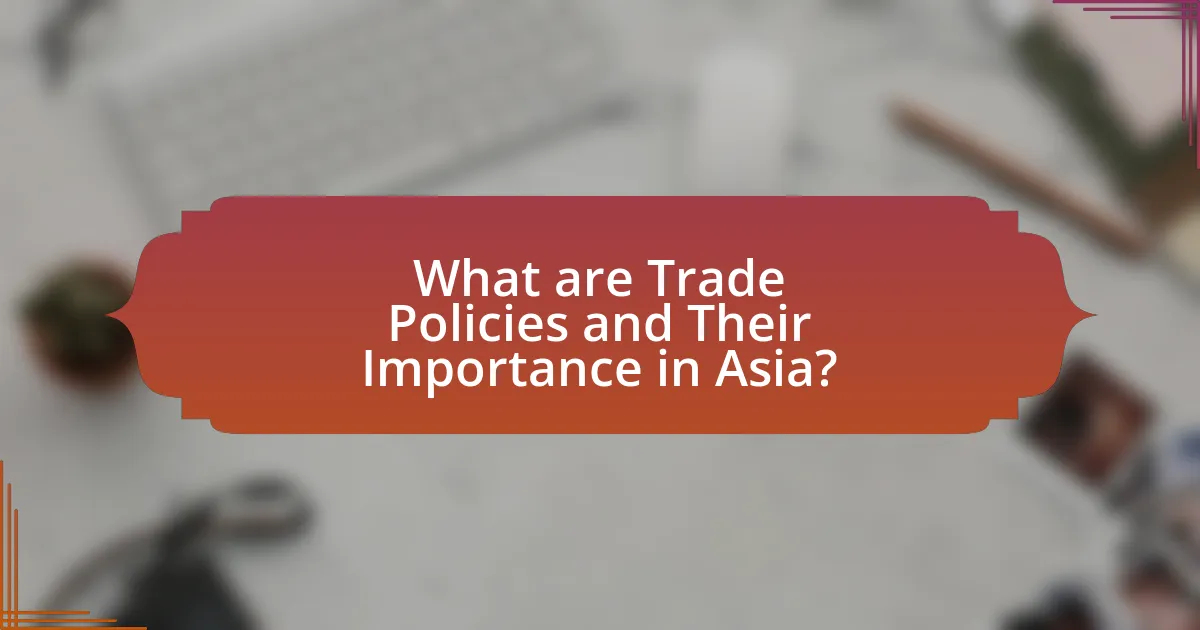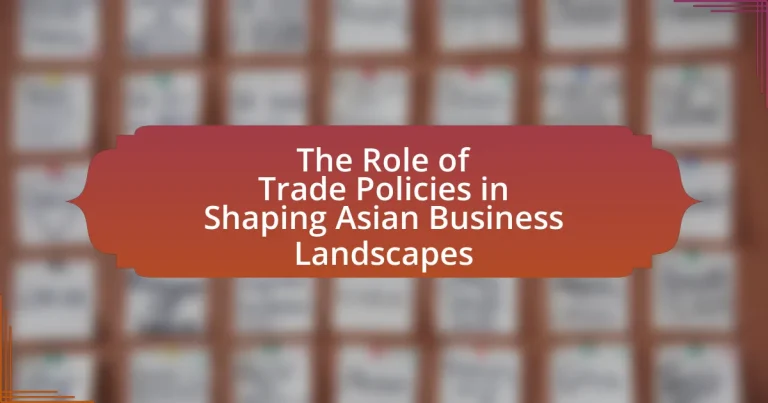Trade policies are essential regulations and agreements that govern international trade in Asia, significantly influencing economic relationships, market access, and competitiveness among countries. This article examines the importance of trade policies, including tariffs, trade agreements, and foreign investment regulations, and their impact on business operations and local industries. It highlights key components such as the ASEAN Free Trade Area and the Regional Comprehensive Economic Partnership, which facilitate trade and investment flows, and discusses how evolving trade policies are adapting to global changes, sustainability, and geopolitical tensions. Additionally, the article outlines best practices for businesses to navigate these policies effectively, ensuring compliance and leveraging opportunities for growth in the dynamic Asian market.

What are Trade Policies and Their Importance in Asia?
Trade policies are regulations and agreements that govern international trade between countries, and they play a crucial role in shaping economic relationships in Asia. These policies determine tariffs, import quotas, and trade agreements, influencing market access and competitiveness. For instance, the Association of Southeast Asian Nations (ASEAN) Free Trade Area has significantly reduced tariffs among member countries, fostering regional trade growth. Additionally, trade policies impact foreign direct investment (FDI); countries with favorable trade policies attract more FDI, which can lead to economic development and job creation. The importance of trade policies in Asia is underscored by the region’s status as a global trade hub, with countries like China and Japan being major players in international markets.
How do trade policies influence business operations in Asia?
Trade policies significantly influence business operations in Asia by determining tariffs, import/export regulations, and market access. These policies affect the cost of goods, competitiveness, and supply chain dynamics. For instance, the ASEAN Free Trade Area, established in 1992, has reduced tariffs among member countries, facilitating increased trade and investment flows, which has led to a 30% rise in intra-ASEAN trade from 2000 to 2019. Additionally, trade agreements like the Regional Comprehensive Economic Partnership (RCEP) further enhance market access for businesses, allowing them to expand operations and optimize production costs. Thus, trade policies are crucial in shaping the operational landscape for businesses in Asia.
What are the key components of trade policies affecting Asian businesses?
The key components of trade policies affecting Asian businesses include tariffs, trade agreements, import/export regulations, and foreign investment policies. Tariffs impose taxes on imported goods, influencing pricing and competitiveness; for instance, the ASEAN Free Trade Area has reduced tariffs among member countries, enhancing intra-regional trade. Trade agreements, such as the Regional Comprehensive Economic Partnership (RCEP), facilitate market access and reduce trade barriers, promoting economic integration. Import/export regulations govern the flow of goods, impacting compliance costs and market entry strategies. Lastly, foreign investment policies determine the ease with which foreign entities can invest in Asian markets, affecting capital inflow and business expansion opportunities. These components collectively shape the operational landscape for businesses in Asia, influencing their strategic decisions and market dynamics.
How do trade agreements shape market access for Asian companies?
Trade agreements significantly enhance market access for Asian companies by reducing tariffs and non-tariff barriers, thereby facilitating smoother entry into foreign markets. For instance, the Regional Comprehensive Economic Partnership (RCEP), which includes several Asian nations, aims to lower tariffs on goods and streamline customs procedures, making it easier for Asian exporters to compete globally. According to a report by the Asian Development Bank, RCEP could boost the region’s GDP by 0.2% to 0.3% annually, illustrating the tangible economic benefits of such agreements. Additionally, trade agreements often include provisions for investment protection and intellectual property rights, further encouraging Asian companies to expand their operations internationally.
Why are trade policies critical for economic growth in Asia?
Trade policies are critical for economic growth in Asia because they facilitate market access, enhance competitiveness, and attract foreign investment. By reducing tariffs and non-tariff barriers, trade policies enable Asian countries to integrate into global supply chains, which has been evidenced by the rapid economic development of nations like China and Vietnam. For instance, according to the World Bank, trade liberalization in these countries has contributed to GDP growth rates exceeding 6% annually over the past two decades. Furthermore, effective trade policies can stimulate innovation and productivity by exposing domestic industries to international competition, thereby driving economic advancement across the region.
What role do trade policies play in attracting foreign investment?
Trade policies significantly influence the attraction of foreign investment by creating a favorable environment for international businesses. These policies, such as tariffs, trade agreements, and regulations, can lower barriers to entry, enhance market access, and provide legal protections for investors. For instance, countries that implement free trade agreements often experience increased foreign direct investment (FDI) due to reduced tariffs and improved trade relations, as evidenced by the ASEAN Free Trade Area, which has led to a notable rise in intra-regional investments. Additionally, transparent and stable trade policies build investor confidence, as seen in nations like Singapore, which consistently ranks high in global investment attractiveness due to its clear regulatory framework and open trade practices.
How do trade policies impact local industries and employment?
Trade policies significantly influence local industries and employment by determining the conditions under which goods and services are exchanged across borders. For instance, protective tariffs can shield domestic industries from foreign competition, potentially leading to job preservation in those sectors. Conversely, trade liberalization, such as reducing tariffs and trade barriers, can enhance market access for local businesses, fostering growth and job creation in export-oriented industries. According to a study by the World Bank, countries that embraced trade liberalization experienced an average GDP growth of 1.5% annually, which often translates into increased employment opportunities. Thus, the nature of trade policies directly shapes the economic landscape, affecting both the viability of local industries and the employment rates within those sectors.

What are the Major Trade Policies Affecting Asian Business Landscapes?
Major trade policies affecting Asian business landscapes include the Regional Comprehensive Economic Partnership (RCEP), the Comprehensive and Progressive Agreement for Trans-Pacific Partnership (CPTPP), and various bilateral trade agreements. RCEP, which came into effect in January 2022, is the world’s largest trade agreement, encompassing 15 countries and aiming to reduce tariffs and enhance trade facilitation among member nations. The CPTPP, which includes countries like Japan, Canada, and Australia, promotes trade liberalization and sets high standards for labor and environmental protections. Additionally, countries such as China and India have engaged in numerous bilateral agreements to strengthen trade ties, impacting regional supply chains and market access. These policies collectively shape the economic interactions and competitive dynamics within Asia, influencing investment flows and trade patterns.
What types of trade agreements exist in Asia?
In Asia, the main types of trade agreements include Free Trade Agreements (FTAs), Regional Comprehensive Economic Partnership (RCEP), and Bilateral Trade Agreements. FTAs, such as the ASEAN Free Trade Area, aim to reduce tariffs and increase trade between member countries. RCEP, which includes 15 Asia-Pacific nations, is the world’s largest trade agreement, promoting economic integration and cooperation. Bilateral Trade Agreements, like those between India and Japan, focus on specific trade relations between two countries, enhancing trade flows and investment opportunities. These agreements collectively shape the economic landscape of Asia by facilitating trade and investment among nations.
How do bilateral and multilateral agreements differ in their impact?
Bilateral agreements primarily impact trade between two countries, fostering direct economic relationships and tailored terms that can lead to increased trade volume and investment between the parties involved. In contrast, multilateral agreements involve multiple countries, creating broader trade frameworks that can enhance market access and reduce tariffs on a larger scale, benefiting all member nations collectively. For example, the Comprehensive and Progressive Agreement for Trans-Pacific Partnership (CPTPP) illustrates how multilateral agreements can facilitate trade among multiple countries, while a bilateral agreement like the U.S.-South Korea Free Trade Agreement focuses specifically on the economic dynamics between the two nations. This distinction in scope and scale leads to differing impacts on trade flows, regulatory harmonization, and economic integration within the respective regions.
What are the implications of free trade agreements for Asian economies?
Free trade agreements (FTAs) significantly impact Asian economies by enhancing trade flows, increasing foreign direct investment (FDI), and fostering economic growth. FTAs reduce tariffs and trade barriers, which leads to a rise in exports and imports among member countries; for instance, the ASEAN Free Trade Area has facilitated a 30% increase in intra-regional trade since its implementation in 1992. Additionally, FTAs attract FDI by creating a more predictable and stable business environment, as seen in Vietnam, where the Comprehensive and Progressive Agreement for Trans-Pacific Partnership has spurred investment in manufacturing sectors. Overall, FTAs contribute to economic integration and competitiveness in Asian markets, driving innovation and efficiency.
How do tariffs and non-tariff barriers affect trade in Asia?
Tariffs and non-tariff barriers significantly restrict trade in Asia by increasing costs and limiting market access. Tariffs, which are taxes imposed on imported goods, raise prices for consumers and reduce demand for foreign products, thereby protecting domestic industries but also leading to trade tensions. For instance, the trade war between the United States and China resulted in tariffs that affected billions of dollars in goods, disrupting supply chains across Asia. Non-tariff barriers, such as quotas, import licensing, and stringent regulations, further complicate trade by creating additional hurdles for exporters. According to the Asian Development Bank, these barriers can lead to a 20% increase in trade costs, hindering economic growth and integration within the region.
What are the most common non-tariff barriers faced by Asian businesses?
The most common non-tariff barriers faced by Asian businesses include import licensing requirements, technical regulations, and sanitary and phytosanitary measures. Import licensing requirements can restrict the quantity of goods that can be imported, impacting market access. Technical regulations often involve compliance with specific standards that can vary significantly between countries, creating challenges for businesses trying to navigate different regulatory environments. Sanitary and phytosanitary measures are designed to protect human, animal, and plant life but can also serve as obstacles to trade if they are overly stringent or not based on scientific evidence. According to the World Trade Organization, these non-tariff barriers can significantly affect trade flows and market dynamics in the region.
How do tariffs influence pricing and competitiveness in Asian markets?
Tariffs increase the cost of imported goods, which directly influences pricing and competitiveness in Asian markets. When tariffs are imposed, domestic producers may raise their prices due to reduced competition from foreign imports, leading to higher consumer prices. For instance, in 2018, the U.S. imposed tariffs on Chinese goods, prompting China to retaliate with tariffs on U.S. products, which affected pricing strategies across various sectors in Asia. This dynamic can lead to a competitive advantage for local businesses that can produce goods at lower costs compared to imported alternatives, thereby reshaping market dynamics. Additionally, tariffs can incentivize domestic production, as companies may seek to avoid tariff costs by sourcing materials locally, further influencing pricing and competitiveness in the region.

How are Trade Policies Evolving in Response to Global Changes?
Trade policies are evolving to address global changes by increasingly prioritizing sustainability, digital trade, and regional cooperation. Governments are adapting their trade agreements to incorporate environmental standards and labor rights, reflecting a growing recognition of the need for sustainable development. For instance, the European Union’s Green Deal aims to align trade policies with climate goals, influencing partner countries to adopt similar measures. Additionally, the rise of e-commerce has prompted countries to revise regulations to facilitate digital trade, as seen in the Comprehensive and Progressive Agreement for Trans-Pacific Partnership (CPTPP), which includes provisions for cross-border data flows. Regional trade agreements are also gaining traction, as countries seek to strengthen economic ties within their regions, exemplified by the Regional Comprehensive Economic Partnership (RCEP) in Asia, which aims to enhance trade and investment among member states. These shifts demonstrate a responsive approach to the dynamic global landscape, emphasizing collaboration and modernization in trade policy frameworks.
What recent trends are shaping trade policies in Asia?
Recent trends shaping trade policies in Asia include the rise of regional trade agreements, increased focus on digital trade, and a shift towards sustainability in trade practices. Regional trade agreements, such as the Regional Comprehensive Economic Partnership (RCEP), which came into effect in January 2022, aim to enhance economic integration among member countries by reducing tariffs and fostering trade in goods and services. Additionally, the emphasis on digital trade has grown, with countries like Singapore and Japan implementing frameworks to facilitate e-commerce and digital transactions, reflecting the increasing importance of technology in trade. Furthermore, sustainability has become a critical consideration, as nations adopt policies that promote environmentally friendly practices, evidenced by initiatives like the ASEAN Green Bond Standards, which encourage investment in sustainable projects. These trends collectively indicate a dynamic shift in how trade policies are formulated and implemented across Asia.
How is digital trade influencing policy development in Asia?
Digital trade is significantly influencing policy development in Asia by prompting governments to create frameworks that facilitate e-commerce and digital transactions. As countries like China and India expand their digital economies, they are implementing regulations that address data privacy, cybersecurity, and cross-border data flows. For instance, the Asia-Pacific Economic Cooperation (APEC) has established initiatives to enhance digital trade, which encourages member economies to adopt policies that support digital platforms and reduce barriers to online trade. This shift is evidenced by the increasing number of free trade agreements in the region that include provisions for digital trade, such as the Comprehensive and Progressive Agreement for Trans-Pacific Partnership (CPTPP), which incorporates chapters on e-commerce.
What role does sustainability play in the evolution of trade policies?
Sustainability plays a crucial role in the evolution of trade policies by driving the integration of environmental considerations into international trade agreements. As global awareness of climate change and resource depletion increases, countries are increasingly adopting trade policies that promote sustainable practices, such as reducing carbon emissions and encouraging the use of renewable resources. For instance, the European Union’s Green Deal aims to make Europe the first climate-neutral continent by 2050, influencing trade policies that prioritize sustainable goods and services. This shift is supported by research indicating that sustainable trade practices can enhance economic resilience and competitiveness, as seen in the rise of green technologies and sustainable supply chains.
How do geopolitical tensions affect trade policies in Asia?
Geopolitical tensions significantly influence trade policies in Asia by prompting countries to adopt protectionist measures and realign trade partnerships. For instance, the ongoing trade disputes between the United States and China have led to tariffs and restrictions that affect supply chains across the region. In response, countries like Vietnam and India have sought to attract foreign investment by offering incentives, thereby reshaping their trade policies to mitigate the impact of these tensions. Additionally, regional agreements such as the Regional Comprehensive Economic Partnership (RCEP) illustrate how nations are attempting to strengthen intra-Asian trade ties as a counterbalance to external pressures. These dynamics demonstrate that geopolitical factors are critical in determining the direction and nature of trade policies in Asia.
What are the consequences of trade wars on Asian businesses?
Trade wars have significant consequences for Asian businesses, primarily leading to increased costs, disrupted supply chains, and reduced market access. For instance, tariffs imposed during trade conflicts, such as the U.S.-China trade war, have raised the cost of imported materials for manufacturers in countries like Vietnam and Thailand, forcing them to either absorb the costs or pass them on to consumers. Additionally, Asian businesses that rely on exports to affected markets face declining sales and profitability due to retaliatory tariffs. According to a report by the Asian Development Bank, trade tensions have contributed to a slowdown in regional economic growth, with projections indicating a potential reduction in GDP growth rates for several Asian economies. This environment creates uncertainty, discouraging investment and innovation among businesses in the region.
How do regional conflicts influence trade agreements and policies?
Regional conflicts significantly disrupt trade agreements and policies by creating instability and uncertainty in affected areas. For instance, ongoing tensions in the South China Sea have led to strained relations between China and several Southeast Asian nations, resulting in hesitance to engage in trade agreements that could be perceived as favoring one party over another. Additionally, conflicts often lead to the imposition of tariffs and trade barriers as countries seek to protect their economic interests and national security. Historical examples include the U.S.-China trade war, where geopolitical tensions prompted both nations to implement tariffs that altered trade flows and affected global supply chains. Such conflicts can also lead to shifts in alliances, as countries may seek new trade partners to mitigate risks associated with regional instability, further complicating the landscape of trade policies.
What best practices can businesses adopt to navigate trade policies in Asia?
Businesses can adopt several best practices to navigate trade policies in Asia effectively. First, they should conduct thorough research on the specific trade agreements and regulations relevant to their industry and target markets, as Asia comprises diverse economies with varying policies. For instance, understanding the Regional Comprehensive Economic Partnership (RCEP) can provide insights into tariff reductions and market access across member countries.
Second, companies should engage local legal and trade experts to ensure compliance with local laws and regulations, which can differ significantly from international standards. This is crucial in countries like China, where regulations can change rapidly and may require local knowledge for effective navigation.
Third, businesses should establish strong relationships with local partners and government agencies to facilitate smoother operations and gain insights into policy changes. Collaborating with local firms can also enhance market entry strategies and compliance with local trade practices.
Lastly, companies should continuously monitor trade policy developments and adapt their strategies accordingly, as trade policies in Asia can be influenced by geopolitical factors and economic shifts. For example, the ongoing trade tensions between the U.S. and China have led to changes in tariffs and trade practices that businesses must stay informed about to remain competitive.
How can companies stay informed about changing trade regulations?
Companies can stay informed about changing trade regulations by subscribing to industry newsletters, engaging with trade associations, and utilizing government resources. Industry newsletters provide timely updates on regulatory changes, while trade associations often offer insights and advocacy on behalf of their members. Government resources, such as official trade websites and regulatory agencies, publish updates and guidelines that are essential for compliance. For instance, the World Trade Organization (WTO) regularly releases reports on trade policy developments that can significantly impact businesses.
What strategies can businesses implement to leverage trade policies for growth?
Businesses can implement strategies such as aligning their operations with trade agreements, utilizing tariff advantages, and engaging in advocacy for favorable trade policies to leverage trade policies for growth. By aligning operations with trade agreements, businesses can access new markets and reduce costs associated with tariffs, as evidenced by the ASEAN Free Trade Area, which has facilitated increased intra-regional trade among member countries. Utilizing tariff advantages allows businesses to price their products competitively in foreign markets, enhancing their market share. Additionally, engaging in advocacy for favorable trade policies can influence government decisions, as seen in the efforts of various industry groups that successfully lobbied for trade agreements that benefit their sectors. These strategies collectively enable businesses to capitalize on trade policies, driving growth and expansion in the Asian business landscape.



